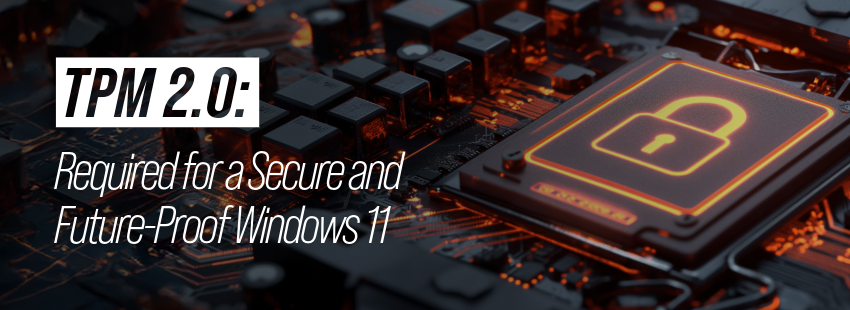We Help Businesses Thrive.
Peace of Mind is closer than you think.
Let's have a quick chat.

On December 3, 2024, Microsoft officially announced the Windows 11 TPM Requirement, marking a significant milestone in enhancing system security. In today’s digital world, security is crucial. Cyber threats grow more sophisticated each day. To combat these dangers, TPM 2.0 has become a requirement for Windows 11. This blog explores why TPM 2.0 is vital, its benefits, and how it ensures a secure and resilient computing future.
Trusted Platform Module (TPM) is a specialized chip on your computer’s motherboard that provides hardware-based security functions. The latest version, TPM 2.0, enhances these features with better encryption algorithms and support for modern security protocols. It acts as a secure vault for cryptographic keys, protecting sensitive data from unauthorized access.
Microsoft’s decision to mandate TPM 2.0 stems from a commitment to robust security and future advancements. Here’s why the Windows 11 TPM 2.0 Requirement is essential for Windows 11:
TPM 2.0 adds a hardware-based security layer that software alone cannot easily breach. By securely storing cryptographic keys, TPM 2.0 ensures that sensitive information remains protected even if malware infiltrates the system.
With TPM 2.0, features like Secure Boot and BitLocker become more effective. Secure Boot verifies the integrity of the boot process. It prevents unauthorized code from running during startup. BitLocker uses TPM to encrypt your data. This ensures your information stays inaccessible to unauthorized users, even if your device is lost or stolen.
As technology evolves, so do threats. TPM 2.0 supports future security protocols and advancements. This makes Windows 11 not only secure today but also adaptable to tomorrow’s challenges. Such forward-thinking ensures your system remains resilient against emerging threats.
Meeting security standards is critical for businesses. TPM 2.0 helps organizations comply with various regulatory requirements and provides a trusted hardware foundation for data protection. This is especially important for industries handling sensitive information, such as finance, healthcare, and government sectors.
TPM 2.0 safeguards against physical tampering. If someone tries to access your device’s hardware, the TPM chip can detect it. This triggers protective measures, ensuring your data remains secure.
Windows 11 enhances password security with TPM 2.0. It enables more secure authentication methods, reducing the risk of unauthorized access through stolen or guessed passwords.
TPM 2.0 supports advanced technologies like biometric authentication and multi-factor authentication (MFA). This integration provides a smoother and more secure user experience. It allows quicker and safer access to your device and applications.
Before upgrading to Windows 11, verify if your PC meets the Windows 11 TPM 2.0 Requirement. Follow these steps:
If your PC lacks TPM 2.0, you might need to enable it in the BIOS/UEFI settings or consider upgrading your hardware, but check with your IT provider first.
Sometimes, TPM is available but not enabled. Here’s how to enable TPM 2.0:
Note: The steps may vary depending on your motherboard manufacturer. Contact your IT professional for assistance in properly setting up TPM and Windows 11.
Many users worry about hardware compatibility with TPM 2.0. While most modern PCs include TPM 2.0, some older systems may not support it. In such cases, updating your motherboard firmware or adding a TPM module might be necessary.
There is a misconception that TPM 2.0 slows down your system. In reality, TPM operations are lightweight and barely affect performance. The security benefits far outweigh any minimal performance considerations.
Some users are concerned about privacy with TPM 2.0. It’s important to understand that TPM enhances security without compromising privacy. Cryptographic keys are stored securely on the hardware and are inaccessible to unauthorized parties, including Microsoft.
Microsoft’s requirement for TPM 2.0 in Windows 11 marks a significant step toward a secure computing environment. By leveraging hardware-based security, TPM 2.0 protects users from current threats and prepares systems for future challenges.
This requirement emphasizes investing in secure infrastructure for businesses. It ensures operations remain resilient against evolving cyber threats. For individual users, it provides peace of mind knowing their data is safeguarded by advanced technology.
As we move forward, TPM 2.0 integration in Windows 11 exemplifies the balance between usability and security. It showcases Microsoft’s dedication to offering a robust, future-proof operating system that stands strong against tomorrow’s challenges.
Ensure your PC meets the Windows 11 TPM 2.0 Requirement now. Check your TPM status, enable TPM 2.0 in your BIOS/UEFI settings, or upgrade your hardware to enjoy enhanced security and a future-proof Windows 11 experience. Need assistance? Contact us to arrange for your Windows 11 Assessment.
Stay Secure. Stay Updated. Embrace the Future with Windows 11 and TPM 2.0.
References

Peace of Mind is closer than you think.
Let's have a quick chat.
Schedule a 15-minute introductory call with our support experts and we'll see what we can do for you.